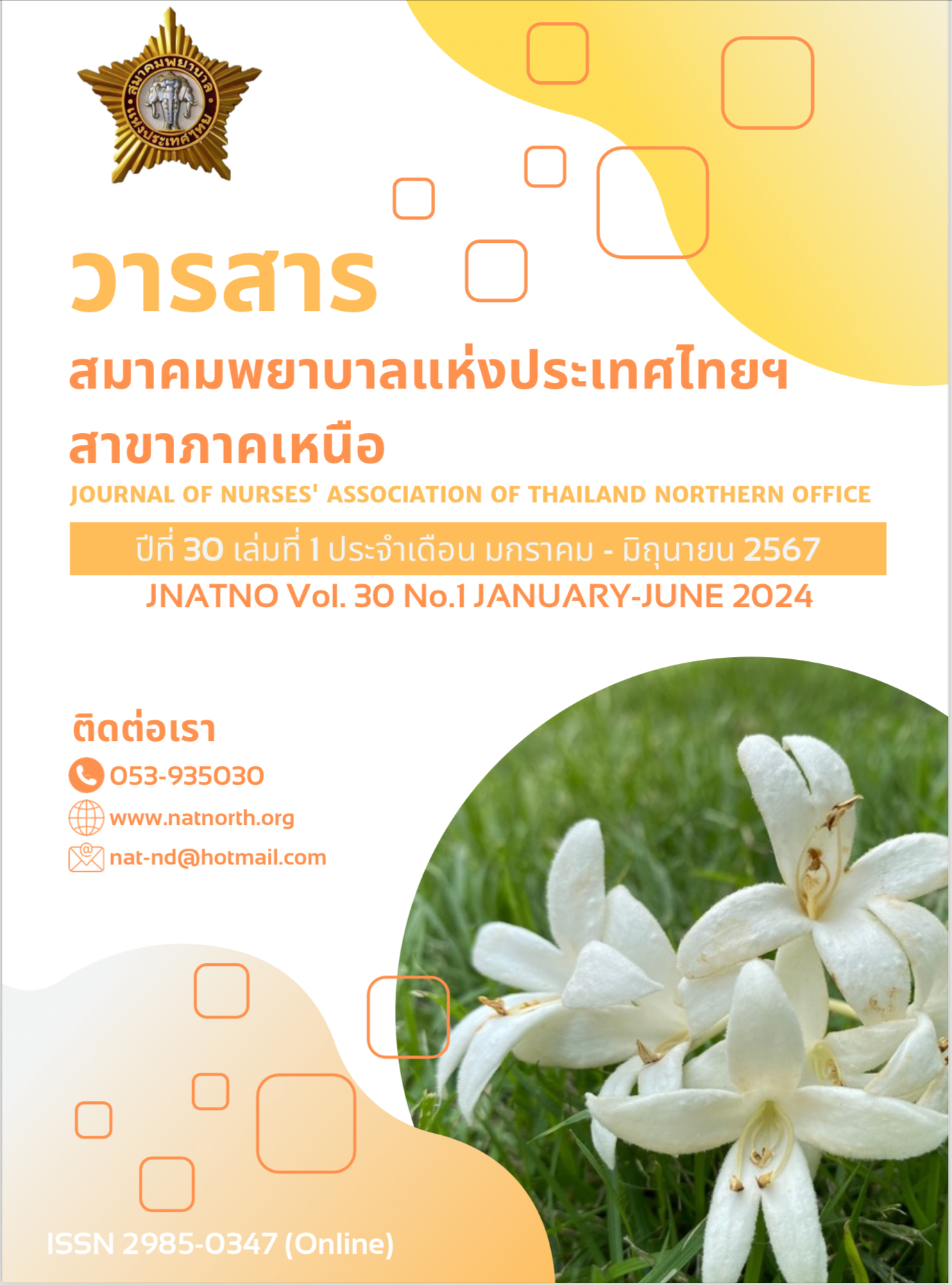การพัฒนาแนวปฏิบัติการพยาบาลทางคลินิก: การจัดการเวลา การให้ยาปฏิชีวนะชนิดฉีดเข้าวงรอบยามาตรฐาน หลังการให้ยาครั้งแรกทันที
คำสำคัญ:
แนวปฏิบัติการพยาบาลทางคลินิก, การบริหารเวลาให้ยา, การให้ยาปฏิชีวนะทางหลอดเลือดบทคัดย่อ
การวิจัยและพัฒนานี้ มีวัตถุประสงค์เพื่อพัฒนาแนวปฏิบัติการพยาบาลทางคลินิก สำหรับการจัดการเวลาการให้ยาปฏิชีวนะชนิดฉีดเข้าวงรอบมาตรฐานหลังการให้ยาครั้งแรกทันที การวิจัยนี้ใช้รูปแบบการวิจัยและพัฒนา ร่วมกับประยุกต์ขั้นตอนจากกรอบแนวคิดในการพัฒนาแนวปฏิบัติทางคลินิกของสภาวิจัยด้านการแพทย์และการสาธารณสุขแห่งชาติ ประเทศออสเตรเลีย กลุ่มตัวอย่าง ได้แก่ กลุ่มพัฒนาแนวปฏิบัติฯ จำนวน 11 คน กลุ่มผู้ใช้แนวปฏิบัติฯ จำนวน 30 คน และกลุ่มผู้ได้รับการดูแลตามแนวปฏิบัติฯ จำนวน 10 คน เครื่องมือวิจัย ประกอบด้วย แบบสอบถามข้อมูลทั่วไปของพยาบาล แบบบันทึกข้อมูลทั่วไปของผู้ป่วย แบบสอบถามความเป็นไปได้ของการใช้แนวปฏิบัติฯ และแบบบันทึกผลลัพธ์ของการใช้แนวปฏิบัติฯ การดำเนินการวิจัย มี 2 ระยะ คือ ระยะที่ 1 การวิจัยเพื่อศึกษาสภาพปัญหา (R1) และ ระยะที่ 2 การพัฒนาแนวปฏิบัติฯ (D1) วิเคราะห์ข้อมูลโดยใช้สถิติเชิงพรรณนา ได้แก่ ค่าความถี่ ร้อยละ ค่าเฉลี่ย และส่วนเบี่ยงเบนมาตรฐาน
ผลการวิจัย: 1) ผลการวิเคราะห์ข้อมูลที่ใช้ในการพัฒนาแนวปฏิบัติฯ ได้หลักฐานเชิงประจักษ์ที่ผ่านเกณฑ์ทั้งหมด จำนวน 6 เรื่อง 2) ได้แนวปฏิบัติฯ ที่มีสาระสำคัญในการปฏิบัติ และตารางการปรับเวลาการให้ยาปฏิชีวนะชนิดฉีดครั้งที่สองหลังการให้ยาครั้งแรกทันทีก่อนเข้าวงรอบมาตรฐานตามกลุ่มรายการยา 3 ตาราง
3) กลุ่มตัวอย่างมีความคิดเห็นต่อความเป็นไปได้ในการนำไปใช้ของแนวปฏิบัติส่วนใหญ่อยู่ในระดับมากทุกหัวข้อ และ 4) ผลลัพธ์เบื้องต้นภายหลังการใช้แนวปฏิบัติฯ พบว่า กลุ่มผู้ใช้แนวปฏิบัติฯ มีการกำหนดเวลาให้ยาปฏิชีวนะชนิดฉีดในผู้ป่วยโรคติดเชื้อถูกเวลาร้อยละ 90 และกลุ่มผู้ได้รับการดูแลตามแนวปฏิบัติฯ ได้รับยาปฏิชีวนะชนิดฉีดครั้งที่สองหลังการให้ยาครั้งแรกทันทีถูกเวลาร้อยละ 90
ดังนั้น แนวปฏิบัติฯ ฉบับนี้มีประสิทธิภาพ พยาบาลสามารถนำไปใช้สำหรับการจัดการเวลาการให้ยาปฏิชีวนะชนิดฉีด เพื่อให้ผู้ป่วยโรคติดเชื้อได้รับผลลัพธ์ที่ดีในการรักษา และปลอดภัยจากการบริหารยา
เอกสารอ้างอิง
ธนะพันธ์ พิบูลย์บรรณกิจ. PKPD Optimized antibiotic therapy. ใน: ดุสิต สถาวร, ครรชิต ปิยะเวชวิรัตน์, สัณฐิติ โมรากุล, บรรณาธิการ. Facing the changes. พิมพ์ครั้งที่ 1. กรุงเทพฯ: สมาคมเวชบำบัดวิกฤตแห่งประเทศไทย; 2562.
Sirima S. Rational drug use and patient safety in critically ills patients: Focus on antibiotic use. ใน: การประชุมวิชาการวิทยาลัยเภสัชบำบัดแห่งประเทศไทย เรื่อง Contemporary reviews in pharmacotherapy 2017; 5-7 กรกฎาคม 2560; กรุงเทพ: วิทยาลัยเภสัชบำบัดแห่งประเทศไทย.
สถาบันรับรองคุณภาพสถานพยาบาล (องค์การมหาชน). มาตรฐานโรงพยาบาลและบริการสุขภาพ ฉบับที่ 4. พิมพ์ครั้งที่ 2. นนทบุรี: สถาบันรับรองคุณภาพสถานพยาบาล (องค์การ มหาชน); 2562.
Levy MM, Evans LE, Rhodes A. The surviving sepsis campaign bundle: 2018 update. Intensive Care Med. 2018;44(6):925-28. doi: 10.1007/s00134-018-5085-0. Epub 2018 Apr 19. PMID: 29675566.
ปรีชา มนทกานติกุล. การให้ยาทันที (STAT) และการปรับเวลาของการบริหารยาให้เข้ารอบการให้ยาปกติ. ใน: ธิดา นิงสานนท์, สุวัฒนา จุฬาวัฒนทล, ปรีชา มนทกานติกุล, บรรณาธิการ. การบริหารยาเพื่อความปลอดภัยของผู้ป่วย. กรุงเทพฯ: สมาคมเภสัชกรรมโรงพยาบาล (ประเทศไทย); 2552.
Randolph JL, Chan K, Albright A, Chen A. Delays in administration of the second antibiotic dose in patients with severe sepsis and septic shock. Hosp Pharm. 2021;56(4): 247-51. doi: 10.1177/0018578719889025.
ปรีชา มนทกานติกุล. การวินิจฉัยทางเภสัชกรรม STAT Drug และ UAP. วารสารเภสัชกรรมโรงพยาบาล. 2551;18(1):88-92.
คณะทำงานด้านการจัดการระบบการดูแลผู้ป่วยภาวะ sepsis พ.ศ. 2561 โรงพยาบาลมหาราชนครเชียงใหม่. แนวทางการบริหารยาปฏิชีวนะ for sepsis protocol 2018 [อินเทอร์เน็ต]. 2561 [เข้าถึงเมื่อ 19 มิถุนายน 2562]. เข้าถึงได้จาก http://www.med.cmu.ac.th/etc/icc/2012/images/files/sepsisguidelinemedicine.pdf.
National Health and Medical Research Council. A guide to the developmental, implementation and evaluation of clinical practice guidelines [Internet]. 1999 [cited 2019 Dec 30]. Available from: https://www.health.qld.gov.au/__data/assets/pdf_file/ 0029/143696/nhmrc_clinprgde.pdf
เอมอร แสงศิริ, วันนา จินดาเพิ่ม. Evidence-based clinical nursing practice guideline Chula, Thai red cross model. (พิมพ์ครั้งที่ 2). กรุงเทพฯ: บุญศิริการพิมพ์; 2565.
สถาบันวิจัยและประเมินเทคโนโลยีทางการแพทย์. เครื่องมือการประเมินคุณภาพแนวทางปฏิบัติสำหรับการวิจัยและการประเมินผล. นนทบุรี: กรมการแพทย์ กระทรวงสาธารณสุข; 2556.
พิกุล นันทชัยพันธ์. การประเมินคุณภาพด้านการนำไปใช้ของแนวปฏิบัติทางคลินิก. ใน: การอบรมเรื่อง การปฏิบัติตามหลักฐานเชิงประจักษ์; 3-4 มิถุนายน 2549; เชียงใหม่: คณะพยาบาลศาสตร์ มหาวิทยาลัยเชียงใหม่; 2550.
The Joanna Briggs Institute. JBI Levels of evidence: Developed by the Joanna Briggs Institute levels of evidence and Grades of recommendation working party October 2013 [Internet]. [cited 2019 Dec 30]. Available from https://joannabriggs.org/jbi-approach.html
โรงพยาบาลราชวิถี. แนวทางการปรับเวลาการบริหารยาปฏิชีวนะชนิดฉีด (IV antibiotics) เข้ารอบมาตรฐานหลังจากมีการบริหารยาครั้งแรกทันที (STAT dose) โรงพยาบาลราชวิถี [อินเทอร์เน็ต]. 2557 [เข้าถึงเมื่อ 25 มกราคม 2563]. เข้าถึงได้จาก http://110.164.68.234/news_raja/ files/q50UoDiTue104427.pdf
หน่วยเภสัชสนเทศ งานคลังเวชภัณฑ์และเภสัชสนเทศ ฝ่ายเภสัชกรรม โรงพยาบาลมหาราชนครเชียงใหม่. ยาฉีด 2020 วิธีบริหาร การเตรียมยา และความคงตัวของยาฉีดในโรงพยาบาลมหาราชนครเชียงใหม่. เชียงใหม่: คณะแพทยศาสตร์ มหาวิทยาลัยเชียงใหม่; 2563.
มารุต พัฒผล. การวิจัยและพัฒนานวัตกรรมหลักสูตรและการจัดการเรียนรู้. วารสารศิลปากรศึกษาศาสตร์วิจัย. 2563;12(1):1-16.
Im Y, Kang D, Ko RE, Lee YJ, Lim SY, Park S, et al. Korean Sepsis Alliance (KSA) investigators. Time-to-antibiotics and clinical outcomes in patients with sepsis and septic shock: a prospective nationwide multicenter cohort study. Crit Care. 2022;26(1):19.doi:10.1186/s13054-021-03883-0.
ดาวน์โหลด
เผยแพร่แล้ว
รูปแบบการอ้างอิง
ฉบับ
ประเภทบทความ
สัญญาอนุญาต
ลิขสิทธิ์ (c) 2024 สมาคมพยาบาลแห่งประเทศไทยฯ สาขาภาคเหนือ

อนุญาตภายใต้เงื่อนไข Creative Commons Attribution-NonCommercial-NoDerivatives 4.0 International License.
บทความที่ได้รับการตีพิมพ์เป็นลิขสิทธิ์ของสมาคมพยาบาลแห่งประเทศไทยฯ สาขาภาคเหนือ
เนื้อหาและข้อคิดเห็นใดๆ ที่ตีพิมพ์ในวารสารสมาคมพยาบาลฯ ถือเป็นความรับผิดชอบของผู้เขียนเท่านั้น ผู้เขียนบทความต้องศึกษารายละเอียดหลักเกณฑ์การจัดทำต้นฉบับตามที่วารสารกำหนด และเนื้อหาส่วนภาษาอังกฤษต้องได้รับการตรวจสอบจากเจ้าของภาษามาแล้ว


